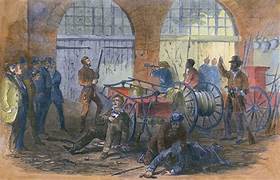On October 18, 1859, the United States witnessed a pivotal event in its history known as the Harpers Ferry Raid. Led by abolitionist John Brown, the raid aimed to incite a slave rebellion and strike a blow against the institution of slavery that was deeply entrenched in the southern states. John Brown, a fervent abolitionist, believed that armed insurrection was necessary to end slavery in the United States. He saw Harpers Ferry, a town in present-day West Virginia, as a strategic location to launch his rebellion due to its proximity to the southern states and its arsenal of weapons. Brown and a small group of followers, including both white and black men, planned to seize control of the federal armory and arsenal at Harpers Ferry. They believed that by capturing the weapons, they could arm enslaved individuals and spark a widespread uprising against their oppressors. On the night of October 16, 1859, Brown and his men took control of the armory and arsenal, capturing several hostages in the process. However, their attempt to rally enslaved individuals to join their cause did not materialize as they had hoped. The local population and militia quickly mobilized against Brown and his followers, trapping them in the armory. Over the course of two days, a standoff ensued between Brown's group and the surrounding forces. Despite their initial success in seizing the armory, Brown and his followers were ultimately outnumbered and outgunned. On October 18, U.S. Marines, led by Colonel Robert E. Lee, stormed the armory, capturing Brown and his surviving followers. The Harpers Ferry Raid had a significant impact on the nation. It further heightened tensions between the North and the South, as the raid exposed the deep divide between those who supported and opposed slavery. Southerners saw the raid as evidence of a widespread conspiracy against their way of life, while many Northerners condemned Brown's methods but sympathized with his cause. The raid also played a role in intensifying the debate over slavery in the United States. It became a rallying point for abolitionists, who saw Brown as a martyr for their cause. At the same time, it solidified the fears of slaveholders, who believed that the North sought to incite slave uprisings and undermine their property rights. Following his capture, John Brown was put on trial and found guilty of treason, murder, and inciting a slave insurrection. On December 2, 1859, he was executed by hanging. Brown's actions and his subsequent trial and execution further polarized the nation, leading to increased tensions that would eventually erupt in the American Civil War. The Harpers Ferry Raid remains a significant event in American history, highlighting the deeply entrenched divisions over slavery that ultimately led to the nation's deadliest conflict. It serves as a stark reminder of the lengths people were willing to go to fight for their beliefs and the profound impact that one person's actions can have on the course of history.
